Let’s start from the beginning. How did you come to the visual arts? Where have you completed your studies? How did your educational path affect your research?
Mircea Nicolae (MN): In 2002, I wrote my BA thesis at the Faculty of Letters at the University of Bucharest. The subject was the House of the People, the second biggest building in the world after the Pentagon. Then, in 2004 I wrote an MA thesis at the Ion Mincu University of Architecture about the transformation of the public space in nineteenth century. To be more precise, the subject was the transition from a religious state to a secular state, in the case of Romania, and the effects that this transition had on the architecture of the local public space. To my surprise, I found out that the change was very literal, meaning that some churches in the center of the city were demolished and then, on the same location, public statues were erected. In 2006 I started research on my PHD. This time, the title was ‘Demolition as a cultural pattern in the case of Bucharest, Romania’. I was trying to argue that in the case of my city, demolition is used in a brutal and exhaustive manner each time the city needs to be modernized, as seen during the demolition campaigns of the 1850s, the 1980s and of the year 2000. At the same time, I was working for an NGO called the International Center for Contemporary Art. This was part of the Soros network of contemporary art centers in Eastern Europe. During doctoral school, I was also exposed to a very interesting class by a visiting professor from Belgium. His name was Hermann Parret. The class was on contemporary art. This mixture of academic information and research about Bucharest, the direct contact with the artworld I had within the NGO I was working for, as well as some of the classes I was being taught during my PHD created a deeper understanding of contemporary art as an interdisciplinary field. In the summer of 2006, when I lost my job at the NGO, I thought I might give it a try.
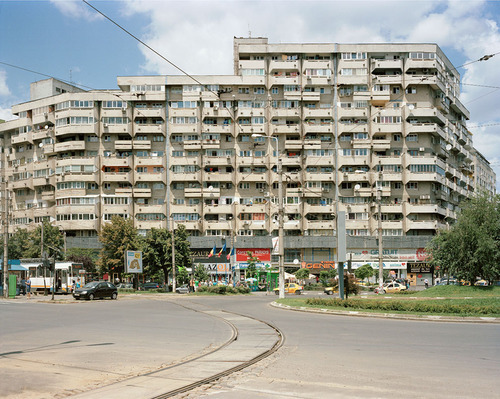
© Mircea Nicolae from the series ‘Blocks of Flats’
You live and work in Bucharest. Your personal works critically engage the city. What struck you the most of your town, for better or for worse?
MN: One of the first things that struck me was the fact that in 1998 when I started my university studies, Bucharest as a city still presented itself as an enigma, even on the academic level. Whether it was the vast demolition and reconstruction of the city in a matter of six years (1983 - 1989) during Communism, or the evolution of the city afterwards, one was left with very scarce academic data to explain the vast, and often mysterious processes that were shaping the city. Later on I would come to know that this vacuum of information was intentional. The demolition of the city in the 1980s, the Revolution of 1989 and the subsequent capitalist development of the country were all under military control, either directly through state institutions, or informally, through corruption networks. This might seem an overgeneralization and a bit of a conspiracy theory, but one can give some tangible arguments in defense of this view.
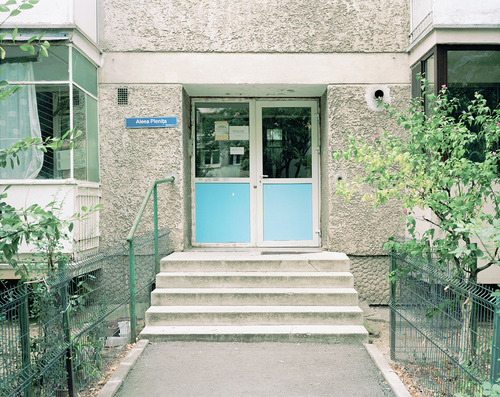
© Mircea Nicolae from the series 'Metal Doors’
To start with, in the 1980, the former demolition sites where the new city was being built were off-limits for the citizens of Bucharest. They were guarded by Secret Police patrols who made sure noone would get in. The plans of the works were secret as well, and they were drawn under the direct supervision and guidance by the leader himself, rather than by architects alone. The largest building site in Eastern Europe in the 80s was in fact a state secret, and it continued to remain so, even if it was placed in the middle of the city. Then, during the Revolution of 1989, the local Communist Party shot the leader and continued to rule the country afterwards. Very little changes in the structure of power occurred. Most of them were due to the change in generations and also due to the makeover from Communist politician to capitalist / democratic party member. As a last example, most of the richest men in Romania are former Secret Police officers. (A good documentary about this is ‘Kapitalism, our Secret Formula’, by director Alexandru Solomon.) So I would say that it is the enigmatic aspect of the city which was in fact most striking for me. This secrecy, and the constant perception of reality as misunderstood, inaccessible and mysterious, in its most mundane aspects. In time I tried to unravel this sort of collective mental haze. Maybe that was my main interest during academic study, and when I was producing art projects, afterwards. However, it took a very long time until I accepted the fact that many of the collective dysfunctions, whether social, psychological or architectural, were in fact a product of conscious will.
In the series 'Playground’ you introduce the theme of modernization and the confrontation with the Communist past. I have recently been to a town in Serbia where I could appreciate this layering of architecture and social histories. How do you feel about this process and how is it changing the face of the city?
MN: To begin with, this process of modernisation is not collective, and it is not democratic. We are in a very peculiar position, because the Communist past was not fully confronted publicly. As a consequence, any Communist remider is being treated with a painful ambivalence. Whether it be a factory, an urban or rural landscape, or even a public swimming pool, these locations are at the same time places of memory, of national pride, and also of deep, painful shame. The resulting behavior always tends to be very emotional. Most of the time the older looking buildings are removed, along with their surrounding landscaping solutions as well as their public furniture. People want the past gone. But then they end up having no past, good or bad. In fact, this interpretation of history is mandated by the state and by its representatives. Because local history would open up a lot of discussion over the economic wealth of the political establishment, the past is devalued in official discourse, and it is also presented as something that is completely over.
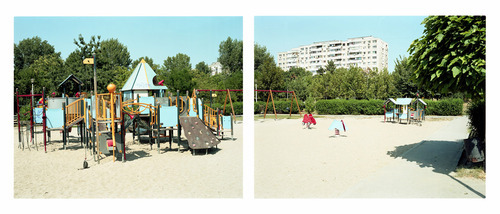
© Mircea Nicolae from the series 'Playgrounds’
However, in real life, the past continues to coexist with the present. Because it was not closed as a chapter in collective memory, it tends to come back as either a nuisance, or under the form of nostalgia.
When modernization takes place, it takes place in this vacuum of rational thought, in this vacuum of will to accept and confront the past, and as this turbulent emotional state of both nostalgia and grief. So at the level of the citizens, things look quite arbitrary. They are not the ones taking the decisions anyway. At the level of the local administration cynicism is high. At the same time, interest is very low with regard to the delicate problems of collective memory and built heritage. Their main interest is to generate a new image of the city and to spend and earn money while doing it. This is not inherently something bad, but it becomes debatable when modernization is chosen by default and refurbishment is refused by default. A post-Communist city needs to confront its local history, to preserve as much as possible from its own past successes of development (I am thinking here of Socialist Modernist architecture and urban environments of moderate to high quality) and to make room for the future within it.
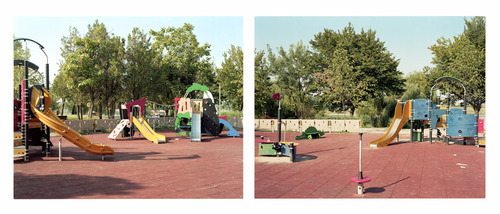
© Mircea Nicolae from the series 'Playgrounds’
What happens in Bucharest is mostly arbitrary from the point of view of continuity. At the same time, it is very logical from the point of view of short-term gain for the administration, as they gain money and votes. However, the change happens without any public discussion on the shape of the city. The citizens, the architects and the urban planners not affiliated with the institutions of state never take part in the decisions. Most of this is quite invisible in the photos. Or maybe it surfaces a little bit when there are block of flats in the background, and a contrast is created between the old and the new.
What is your favorite project? I really like 'The Bus Stop’. I find it rich in meaning and reading levels.
MN: I also like it a lot. Compared with the other projects on my website it is also a bit different from a technical point of view. For this one, I was able to use a better scanner because I had a production budget, so this adds up to the pre-existing content of the images. At times, it’s also quite funny to take those pictures. Buses come at regular intervals, and even if you are in the same place after ten minutes, the image is completely different because of the way people move, or how they wait.

© Mircea Nicolae from the series 'The Bus Stop’
However, there is a level where I am less interested in the aesthetics of the image, and more in the bare recording of urban landscapes. Often, as a more or less informed viewer, it is less the composition or the visual interest that matters. Sometimes I do feel that the surrounding reality of my city is a very well-thought artefact. Because I have been living and observing it for some time, there are either private pleasures, or anthropologic observations that come up while taking photos. I am not sure I am able to communicate many of these insights. This is where I feel that photography fails me sometimes, as compared with either performance or installation. If I take the ‘Façade’ project for example, I would agree with anyone who would tell me it is boring. At the same time I would remain convinced of its importance. The temptation of making the photo more charming is very powerful in moments like these. Using either visual violence, nostalgia, or grief, one could easily come up with some short-term solution. However, I am quite attached to the idea of the banal as banal, not as spectacular.
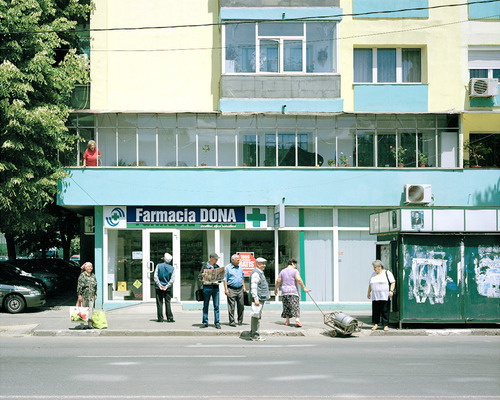
© Mircea Nicolae from the series 'The Bus Stop’
Also, I am just as attached to a type of photography that does not try to prove something if the subject matter does not really sustain that sort of effort. At the same time, I really dread any sort of expressionism and exaggeration for the sake of artistic effect. In a way, I have consciously chosen a very modest and unappealing type of photography. This is most evident in the ‘Facades’ and in the ‘Zebra Crossing’ series. I find this to be a very ambiguous, self-effacing and difficult approach. One could get a lot more with other means. Like shooting landscapes from the top of the hill with a very wide lens. That works too, and it’s beautiful, but it is not what I want to do. So I could say that from the point of view of what I have chosen in terms of visual aspect, and from the point of view of my previous interest in the city, it is more the city itself that I find interesting, and in this case, the photos are more like a result of that. It might also be that I have not given this a thoroughly photographic solution. However, I feel at times, when I do not hear the nagging of my own critical faculty, nor that of others, that it is this very quiet and unassuming type of image that interests me. The idea for the future would be not to give it up, but to become better at it, and open up the insights that I get from the object into a more visual realm that can be communicated more thoroughly.
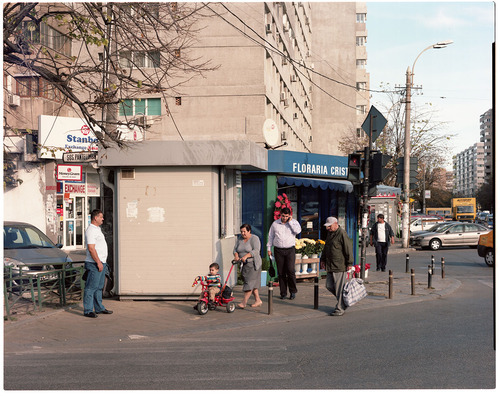
© Mircea Nicolae from the series 'Zebra Crossing’
With this in mind, I like any of these projects as long as they help me see the city better, in a more detailed manner, and as long as they further my understanding of Bucharest. There is always a sense of beauty in this, but it is the beauty of the city that you discover through research, the beauty of the thing that fascinates and opens itself for understanding. Maybe photography is only instrumental in this process, although it seems to have some finality in itself at first.
You have recently been invited to introduce your works on Filmessay’s 'special guest’ programme. I am very impressed by your videos as recordings of performances. I see them conceptually close to the avant-garde of the sixties and seventies that see art as a real practice. Compared to your photography series we find the same critical attention and willingness to discuss social or environmental issues yet the artist becomes part of the scene. Could you introduce us to your latest video works?
MN: In the story that I told at the beginning of the interview there is a missing part. When I started to do art projects I engaged in a two-year attempt at doing one hundred interventions in public and deserted places.
By their definition, interventions are a mixture of conceptual art, site-specific sculpture and performance. So formally and conceptually, I think most of these videos come from that context. Indeed, there is also a wish to attain that level of art as real practice. However, lately I have become aware of the inherent limitations of this very position. One of them is the fact that you can more easily change a mentality, rather than a given reality. Nevertheless, the action is still liberating, as long as it is aware of the modest scale of its impact.
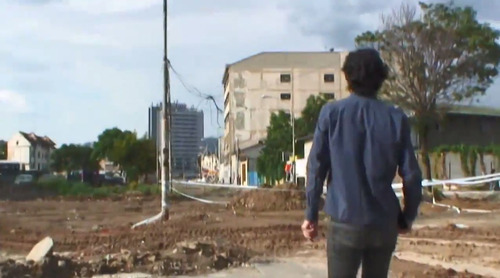
© Mircea Nicolae, still from the video 'Minimum Wage’
The first video is called ‘Minimum Wage’. In short, I threw away the minimum wage, while walking on a given boulevard in the city. Some people noticed and started to pick up the bills. I was trying to make an symbolic gesture about the contrast between the high budget for the modernisation of a given area of the city and the very low income the inhabitants had.
The second video is called ‘Feces and Urine’. Here, I collected my feces and urine in jars, for a week. I then presented them as an installation and a performance at the Centre for Contemporary Dance in Bucharest.
Up until recently, Bucharest had no functional water treatment plant, even if it had absorbed the EU money to build one. Three milion people live in Bucharest, and all their feces and urine ends up directly in the Danube river, and then into the Black Sea.

© Mircea Nicolae, still from the video 'Feces and Urine’
The third video is called ‘How Bread is Made’. It deals with advertising leaflets that invade the mailboxes on a regular basis. I had noticed the people in my building made a special box for throwing the leaflets away as soon as they were received. Because advertisements are some sort of food for the imagination of the consumer, I made four loaves of bread out of a month’s worth of leaflets from the advertising thrash bin. Then I threw them away.
More generally I see your research as very versatile and experimental. Also it does not become an end in itself but it is open to dialogue and reflection on everyday ways of life in the contemporary world. What lead you to this and what are your plans for the future?
MN: As I said above, I began producing art projects in 2006. That year I lost my job. Also, my lover left me and went to the US. In a way, I mention this moment in my life because I ended up in this position both as a result of my interest in a variety of topics, but also because of chance. At a given moment I was forced to get out of the house. I ended up in the public space, and then in the art system. In time, most of my projects were shaped by an enthusiasm for the city I live in, and by a deep admiration for the artists I was discovering. I have many plans for the future, but they change rapidly, as with anyone else. Most of them depend on good health. To give a very dry answer, the most persistent of them is to finish the projects I have already begun and then gather strength, and move on.
---
LINKS
Mircea Nicolae
Romania
share this page